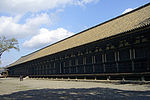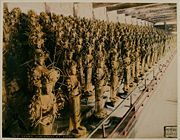
Sanjusangen-do
Encyclopedia

Higashiyama-ku, Kyoto
' is one of the eleven wards in the city of Kyoto, in Kyoto Prefecture, Japan. It was created in 1929 when it was split off from Shimogyō-ku. During the years 1931 to 1976 it also covered the area of present-day Yamashina-ku, which was an independent town until its merger into the city in 1931...
of Kyoto
Kyoto
is a city in the central part of the island of Honshū, Japan. It has a population close to 1.5 million. Formerly the imperial capital of Japan, it is now the capital of Kyoto Prefecture, as well as a major part of the Osaka-Kobe-Kyoto metropolitan area.-History:...
, Japan
Japan
Japan is an island nation in East Asia. Located in the Pacific Ocean, it lies to the east of the Sea of Japan, China, North Korea, South Korea and Russia, stretching from the Sea of Okhotsk in the north to the East China Sea and Taiwan in the south...
. Officially known as "Rengeō-in" (蓮華王院), or Hall of the Lotus King, Sanjūsangen-dō belongs to and is run by the Myoho-in temple, a part of the Tendai
Tendai
is a Japanese school of Mahayana Buddhism, a descendant of the Chinese Tiantai or Lotus Sutra school.Chappell frames the relevance of Tendai for a universal Buddhism:- History :...
school of Buddhism. The temple name literally means Hall with thirty three spaces between columns, describing the architecture of the long main hall of the temple. From the Edo period, archery exhibition contests called Tōshiya
Tōshiya
The or the arrows which hit the target, was an archery exhibition contest held on the west veranda of Sanjūsangen-dō temple in Kyoto, Japan.-History of the contest:...
are held on the west veranda of this temple.
History
Taira no KiyomoriTaira no Kiyomori
was a general of the late Heian period of Japan. He established the first samurai-dominated administrative government in the history of Japan.After the death of his father Taira no Tadamori in 1153, Kiyomori assumed control of the Taira clan and ambitiously entered the political realm in which he...
completed the temple under order of Emperor Go-Shirakawa
Emperor Go-Shirakawa
Emperor Go-Shirakawa was the 77th emperor of Japan, according to the traditional order of succession...
in 1164. The temple complex suffered a fire in 1249 and only the main hall was rebuilt in 1266. In January, the temple has an event known as the Rite of the Willow (柳枝のお加持), where worshippers are touched on the head with a sacred willow branch to cure and prevent headaches. A popular archery tournament known as the Tōshiya
Tōshiya
The or the arrows which hit the target, was an archery exhibition contest held on the west veranda of Sanjūsangen-dō temple in Kyoto, Japan.-History of the contest:...
(通し矢) is also held here on the same grounds since the Edo period
Edo period
The , or , is a division of Japanese history which was ruled by the shoguns of the Tokugawa family, running from 1603 to 1868. The political entity of this period was the Tokugawa shogunate....
.
The duel between the famous warrior Miyamoto Musashi
Miyamoto Musashi
, also known as Shinmen Takezō, Miyamoto Bennosuke or, by his Buddhist name, Niten Dōraku, was a Japanese swordsman and rōnin. Musashi, as he was often simply known, became renowned through stories of his excellent swordsmanship in numerous duels, even from a very young age...
and Yoshioka Denshichirō, leader of the Yoshioka-ryū
Yoshioka-ryu
is a koryū Japanese sword-fighting martial art and is part of the Kyohachi-ryū. The Yoshioka-ryū became famous during the latter half of the 16th century when Yoshioka Kenpo was assigned to be the sword instructor of the Ashikaga shoguns in Kyoto.The Yoshioka-ryū was founded in the first half of...
, is popularly believed to have been fought just outside Sanjūsangen-dō in 1604.
Important features

Avalokitesvara
Avalokiteśvara is a bodhisattva who embodies the compassion of all Buddhas. He is one of the more widely revered bodhisattvas in mainstream Mahayana Buddhism....
or the Thousand Armed Kannon. The statue of the main deity was created by the Kamakura
Kamakura shogunate
The Kamakura shogunate was a military dictatorship in Japan headed by the shoguns from 1185 to 1333. It was based in Kamakura. The Kamakura period draws its name from the capital of the shogunate...
sculptor
Sculpture
Sculpture is three-dimensional artwork created by shaping or combining hard materials—typically stone such as marble—or metal, glass, or wood. Softer materials can also be used, such as clay, textiles, plastics, polymers and softer metals...
Tankei
Tankei
Tankei was a Japanese sculptor of the Kei school, which flourished in the Kamakura period. He was the student of and son of the master sculptor Unkei.-Famous Works:...
and is a National Treasure of Japan
National treasures of Japan
National Treasures are the most precious of Japan's Tangible Cultural Properties, as determined and designated by the Agency for Cultural Affairs...
. The temple also contains one thousand life-size statues of the Thousand Armed Kannon which stand on both the right and left sides of the main statue in 10 rows and 50 columns. Of these, 124 statues are from the original temple, rescued from the fire of 1249, while the remaining 876 statues were constructed in the 13th century. The statues are made of Japanese cypress
Chamaecyparis obtusa
Chamaecyparis obtusa is a species of cypress native to central Japan.It is a slow-growing tree which grows to 35 m tall with a trunk up to 1 m in diameter. The bark is dark red-brown...
. Around the 1000 Kannon statues stand 28 statues of guardian deities. There are also two famous statues of Fūjin
Fujin
is the Japanese god of the wind and one of the eldest Shinto gods.He is portrayed as a terrifying dark demon, resembling a red headed black humanoid wearing a leopard skin, carrying a large bag of winds on his shoulders....
and Raijin
Raijin
is a god of lightning, thunder and storms in the Shinto religion and in Japanese mythology.His name is derived from the Japanese words rai and shin . He is typically depicted as a demon beating drums to create thunder, usually with the symbol tomoe drawn on the drums...
.
See also
- Glossary of Japanese BuddhismGlossary of Japanese BuddhismThis is the glossary of Japanese Buddhism, including major terms the casual reader might find useful in understanding articles on the subject. Words followed by an asterisk are illustrated by an image in one of the photo galleries...
, for an explanation of terms concerning Japanese Buddhism, Japanese Buddhist art, and Japanese Buddhist architectureJapanese Buddhist architectureJapanese Buddhist architecture is the architecture of Buddhist temples in Japan, consisting of locally developed variants of architectural styles born in China... - List of National Treasures of Japan (sculptures)
- List of National Treasures of Japan (temples)

